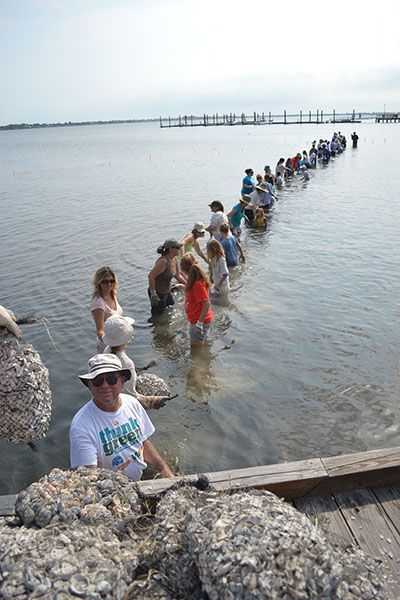
By Vincent Encomio, Ph.D
Although we all enjoy eating a great meal, we often don’t think about where our food came from, let alone the role that food might have played in its environment. Perhaps its naiveté, indifference, or denial, but the dish on your plate, from the most mundane highly selected crop to the wildest fish, was once part of a network of physical, chemical and biological interactions – trophic webs, host-symbiont, or predator-prey relationships. And despite the chef ’s cleaning, peeling, filleting, breading or other attempts to make your food appear to be something other than what was once a living organism, sometimes the hard evidence is right in front of you. Case in point, the oyster, as oysters are one of the few foods that we eat live and whole, except for its skeleton, the shell. Next time you are about to eat a plate of raw oysters take a look at the shells. On those shells you might often see some attached mussels, a few barnacles still glued on here and there. And perhaps more significantly, you may even see smaller oysters attached to these shells. The life cycle of an oyster is dependent on those smaller oysters attaching to other larger oysters (dead or alive) to eventually create a complex reef. Other animals such as mussels and barnacles will also adhere to this reef. The nooks and crannies created by this complex of cemented oyster shell results in numerous places for crabs and fish to hide and reside in. The animals you see attached to that one oyster shell on your dinner plate are a microcosm of rich and diverse oyster reef habitat, a vital resource to the world’s estuaries.

Estuaries are known as the ocean’s nurseries and habitats within estuaries such as tidal marshes, mangrove swamps, and seagrass beds provide homes for numerous species. Oyster reefs are one of those habitats, providing several key benefits, or ecosystem services, to our estuaries. Oysters are widely touted for their ability to filter and clean water. Because they are reef-forming (oysters are actually the dominant reef-forming organism in temperate waters), they also protect shorelines and provide habitat (like those mussels and barnacles attached to your half-shell) for other species. Despite these benefits, oyster reefs are one of the most imperiled aquatic habitats in the world, with an historical loss of greater than 85% due to over-fishing, water diversions, disease or pollution.
In recent years, the ecological value of oyster reefs has been widely recognized, leading to oyster restoration projects across the country. Restored oyster reefs are typically created by depositing oyster shell, or other suitable material, on the bottom. The shell serves as surfaces for new baby oysters, or spat, to attach. It is not easy for oyster restoration programs to acquire oyster shell, however. Shell from whole oysters served in restaurants, raw bars and seafood markets are often thrown away and lost to the landfill, along with their potential for restoring habitat. One method of obtaining this oyster shell has been through the formation of shell recycling programs, in which discarded shell is collected from restaurants for oyster reef restoration. Shell recycling has become an integral component of community-based oyster restoration programs. Community based oyster restoration is just that: volunteers create oyster reefs by constructing and deploying mesh bags filled with recycled oyster shell or “oyster mats”, oyster shells affixed to a rigid mesh. Often, dozens or even hundreds of volunteers at a time come out to help build reefs. These efforts have been instrumental in not only restoring oyster habitat, but also serve to educate, engage and galvanize local communities nationwide, in improving our estuaries.
The Florida Oceanographic Society (FOS) has operated a shell recycling program since 2007. As part of FOS’ oyster restoration program (aka FL.O.O.R. – Florida Oceanographic Oyster Restoration), oyster (and also clam and mussel) shell is collected weekly from several local restaurants.
The next time you are about to enjoy a dozen (or more!) oysters, stop and think about the leftovers, the shell, not as trash to be discarded, but as the small building block of an oyster reef. It functioned as habitat once, it can do so again! Those recycled shells will create new oyster reefs that will clean the water, reduce erosion and provide homes for numerous species. Ask your local restaurant if they recycle their shells and encourage them to participate in a local shell recycling program. Your estuary will thank you for that!
For more information on shell recycling, please contact the Florida Oceanographic Society at info@floridaocean.org. Vincent earned his Ph.D. in Marine Science by comparing the effects of disease on oyster biochemistry and physiology among oyster stocks with varying disease tolerance at the Virginia Institute of Marine Science.
Vincent earned his Ph.D. in Marine Science by comparing the effects of disease on oyster biochemistry and physiology among oyster stocks with varying disease tolerance at the Virginia Institute of Marine Science. For more information on the Florida Oceanographic Society, visit www.floridaocean.org.